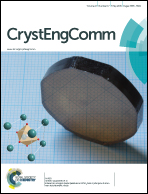The nature of the C–Br⋯Br–C intermolecular interactions found in molecular crystals: a general theoretical-database study†
Abstract
The nature of the C–Br⋯Br–C intermolecular interactions has been evaluated by doing first-principles calculations on model dimers and on full-sized dimers extracted from crystals deposited in the Cambridge Structural Database presenting short-distance C–Br⋯Br–C contacts. First of all, the strength of the C(spn)–Br⋯Br–C(spn) interaction was determined at the MP2/CBS level on model dimers placed at their most stable orientation, getting values of −1.72, −1.83, and −1.91 kcal mol−1 for n = 3, 2 (non-aromatic), and 1, respectively. SAPT analyses of the interaction energy showed that it is dominated by the dispersion term, although a strong electrostatic component is also present, which depends on the fragment dipole moment (induced by the substituents attached to the two C atoms involved in the C–Br⋯Br–C interaction) and the σ-hole of the halogen atoms (induced by the asymmetry of the electron density around each bromine atom). The angular dependence of the C–Br⋯Br–C interactions was determined by computing the Eint(θ1,θ2) surface (where θ1 and θ2 are the ∠C–Br⋯Br and ∠Br⋯Br–C angles) for the (CH3Br)2 dimer. The most stable orientations were found at θ1⋯θ2 = 90° (a case of Type I orientation) and at θi ≈ 180° and θj ≈ 90° (Type II orientation). The Eint(θ1,θ2) surface also showed that the θ1 = θ2 = 150° orientation has the lowest energy among all Type I, but rather than a minimum, it should be considered as a saddle point between both Type II minimum energy orientations. Finally, in order to gain information on the properties of the C–Br⋯Br–C interactions in real cases, the interaction energy was evaluated for 39 dimers extracted from the Cambridge Structural Database that present C–Br⋯Br–C interactions smoothly distributed over the 3.0–4.5 Å range. This allowed establishment of the overall stabilizing nature of these interactions in complex molecules (all have interaction energies that range from −2.35 to −0.38 kcal mol−1, with an average value of −1.26 kcal mol−1). The correlation between stronger interaction energies and higher electron density values at the Br⋯Br bond critical point was shown to be incorrect for sub-van der Waals C–Br⋯Br–C interactions.


 Please wait while we load your content...
Please wait while we load your content...